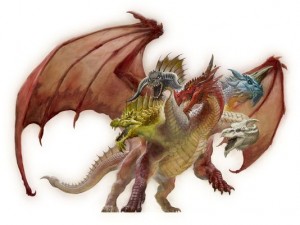 For the first time in six years, gaming fans will roll the dice with a new set of rules for the iconic role-playing game Dungeons & Dragons.
For the first time in six years, gaming fans will roll the dice with a new set of rules for the iconic role-playing game Dungeons & Dragons.
Publisher Wizards of the Coast will launch this with the fresh story Tyranny of Dragons this summer, the latest chapter of the role-playing game first launched 40 years ago.
The next chapter for Dungeons & Dragons will spread across multiple modern platforms, including a new tabletop adventure, and similar experiences for console video game systems and mobile devices.
“This is a huge year for us,” says Nathan Stewart, brand director for D&D at games publisher Wizards of the Coast. “At the heart of Dungeons and Dragons, it’s adventure.”
Tyranny of Dragons pits players against throngs of dragons, led by their five-headed queen Tiamat. Players will get to battle Tiamat — who has appeared in D&D lore as a key villain since the mid-’70s — for the first time in an official D&D adventure.
“It’s really epic in terms of scale,” says Stewart.
This year marks the 40th anniversary of Dungeons & Dragons, first sold as a tabletop game in 1974 by creators Gary Gygax and Dave Arneson.
The duo met in 1969 at Wisconsin’s Lake Geneva Wargames Convention, known today as “Gen Con,” says Jon Peterson, author of the book Playing at the World, which explores the history of war games and role playing games. As part of his research, Peterson interviewed Gygax and Arneson before their deaths in 2008 and 2009 respectively.
As tabletop war games such as Gettysburg and D-Day flourished during the 1960s, Gygax gave them a medieval spin with his creation called Chainmail. Inspired by authors such as Lord of the Rings scribe J.R.R. Tolkien, Chainmail featured a fantasy adventure filled with dragons, wizards and orcs.
Arneson later adapted Gygax’s game into his own adventure called Blackmoor, which had players scour a dungeon for treasure while fending off monsters.
“This was kind of the chocolate and peanut butter moment,” says Peterson. “Arneson showed Gygax the variance he built on Chainmail, and that sparked the collaboration that became Dungeons & Dragons.”
The franchise is best known for its tabletop experience, where players create a character and guide them through a variety of battles and adventures. The game — often played in groups — features one person as a Dungeon Master, who governs and interprets the rules of the game and advances the story.
Several versions of the tabletop game have launched since then, each with updates to the standard rules. D&D has also spread its reach across books, video games such as Baldur’s Gate, and even a Dungeons & Dragons cartoon series that aired on ABC in the mid-’80s. Over 20 million people have played D&D worldwide, says Wizards of the Coast.
Dungeons & Dragons introduced concepts used in nearly every modern video game, such as earning experience through your adventures and “leveling up” to indicate greater proficiency in a certain craft, says Peterson.
“D&D taught us how to be a character in a game and to make choices for them,” says Peterson. “They inform virtually all the video games that we play today.”
Among the countless video game developers influenced by D&D is Tim Willits, studio director at id Software (Doom, Wolfenstein). Introduced to the game by his older brother, Willits was fascinated by map creation, using graph paper to build out quests. These early adventures led him to video game level design, where he worked on id titles such as Quake and Rage.
“A lot of the imagination that stoked (video) game design in the early ’90s came from all of us playing D&D,” says Willits, adding the game offered “a lot of inspiration” for id Software’s work.
Amir Rao, studio director at Supergiant Games, says the inclusion of a narrator in their hit action title Bastion was partly influenced by D&D’s use of the Dungeon Master. Rao started playing D&D in the fourth grade, and continues to play with friends regularly.
“I think so many people wanted to see a digital version of their own campaign story,” says Rao of D&D’s inspiration on video game designers. “I wouldn’t be surprised if so many of the RPGs and action RPGs that we enjoy today come almost directly out of someone’s amazing 10-year campaign that they had with their friends.”
Wizards of the Coast plans a massive celebration for D&D’s 40th anniversary, culminating this summer with the arrival of Tyranny of Dragons.
Wizards of the Coast would not elaborate on how the rules in Tyranny of Dragons might differ from earlier games, but Stewart notes it will drive experiences across all tabletop and digital platforms.
“Obviously, you’re going to be the heroes, save the day, defeat the evil,” says Stewart. “But the important thing about that is the stories you’re going to tell after and these friendships you’re going to form.”
While the franchise presses forward, Dungeons & Dragons continues to have a significant impact on interactive entertainment.
“We’re moving away from a culture where the main way we interact with the story is to read it or to watch it on a screen,” says Peterson. “Instead, we play through it. We’re a protagonist, and we make choices that matter. That gives us a level of investment and immersion in stories that just wasn’t available to us before D&D.”
Original article plucked from USA Today click here to view.
Be the first to comment on "Details of next ‘Dungeons & Dragons’ revealed"